Frames share an important relationship with an artwork, knowing how to care for them will reduce risks faced by a painting if it is kept in a contaminated or unstable surrounding. Specifically, gilded frames post challenges in their care due to the often historic nature of their construction and the delicacy of gold leaf.
This guide will help you gain a better understanding of how to handle and care for decorative gilded frames, which in turn will help you to preserve the artwork it holds.
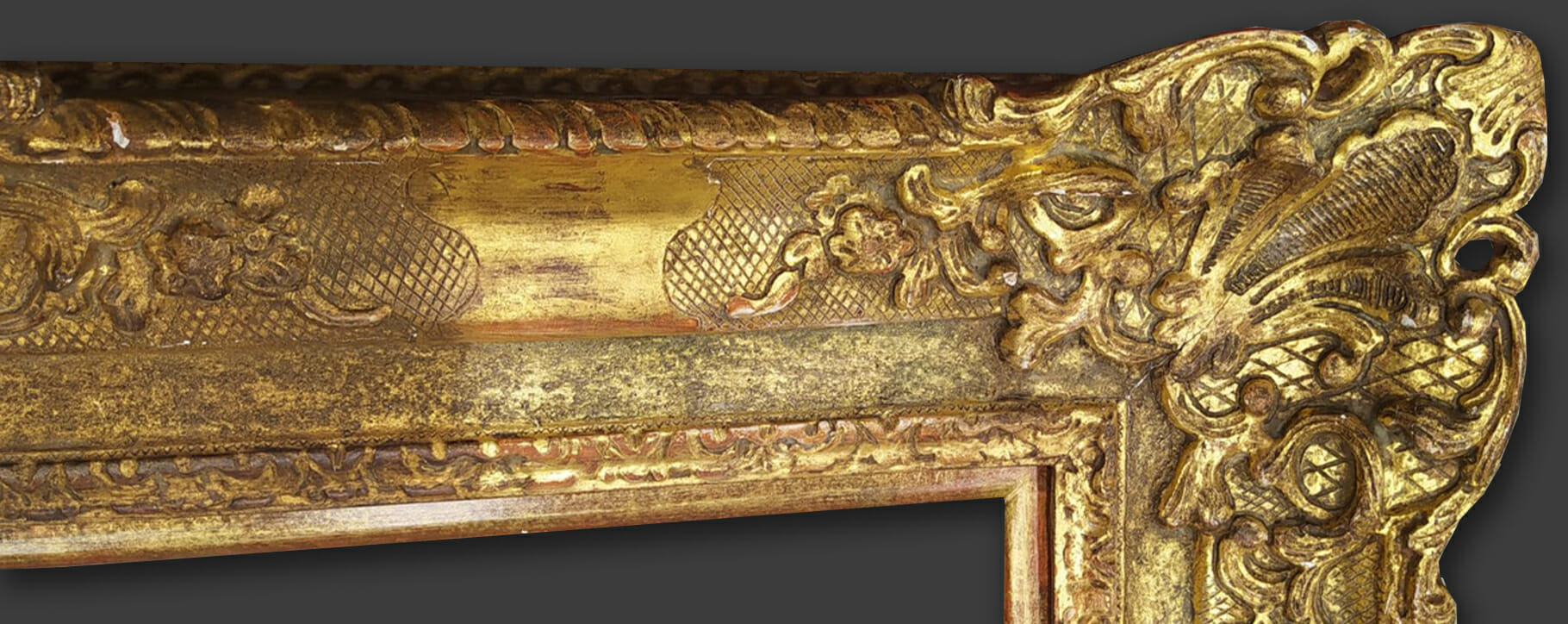 Above: a gilded frame at the beginning of the restoration process, some areas have been cleaned of contamination build-up
Above: a gilded frame at the beginning of the restoration process, some areas have been cleaned of contamination build-up
Handling gilded frames
If you look closely at the surface of a frame you may be able to see fingerprint shaped marks in the gilding. This is due to oils, salts and moisture which are left behind on the surface after being touched with bare hands. When moving or handling a gilded frame, nitrile or clean cotton gloves should be worn to stop the transfer of substances which could damage the gilding over time. Some heavy frames may be difficult to grip easily with gloves on, in which case make sure to wash and dry your hands thoroughly before holding it.
Be careful when carrying frames as the joints can be more fragile than they seem. Hold the frame by the bottom and vertical edge to distribute the weight safely. Large pieces of moulding and decoration on frames can be fragile, so be careful to not rest the frame on these areas or grip onto them when moving it.
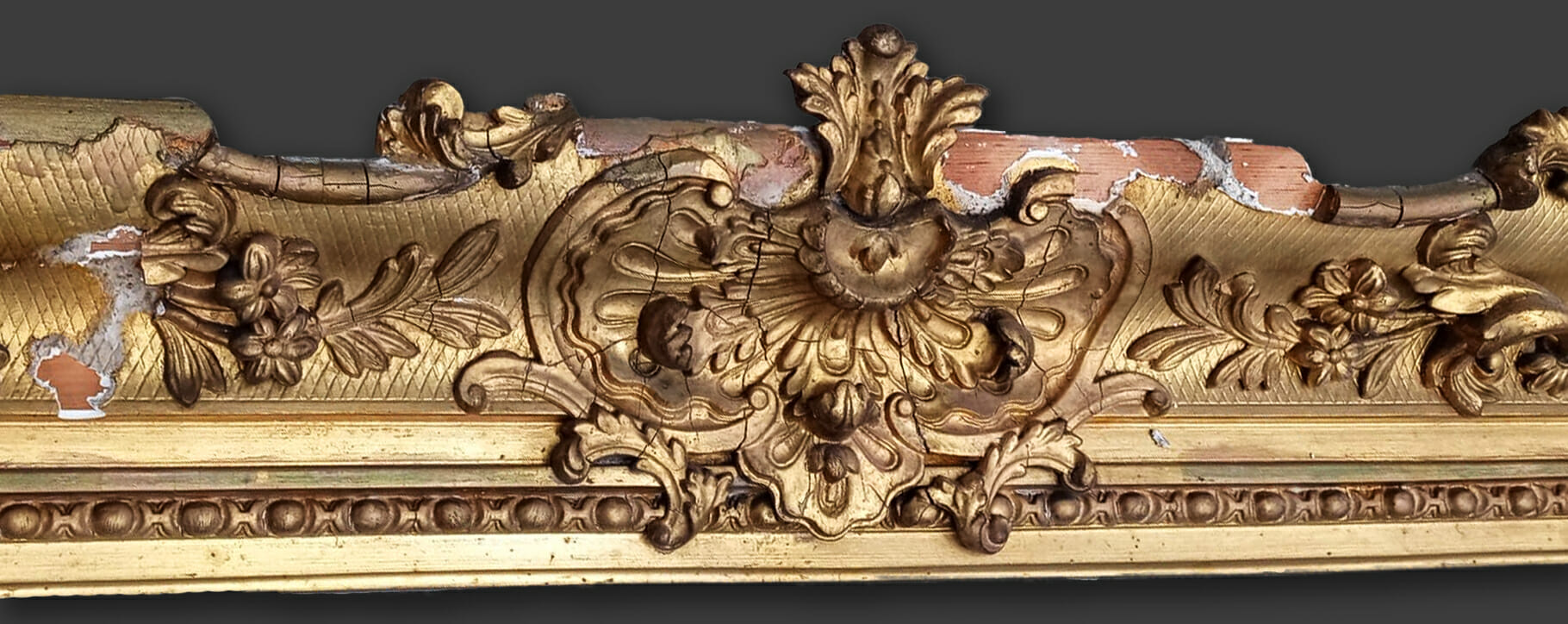 Above: a gilded frame with broken features and a cracking surface prior to restoration work
Above: a gilded frame with broken features and a cracking surface prior to restoration work
If you’re transporting or storing frames there are a few ways to prevent accidental damage. It should first be wrapped in a stable, conservation grade material such as acid free tissue or paper, or a stable plastic such as polythene, to protect the gilded surface from loss and abrasion.
During transport protective packaging will reduce the impact of shock and vibrations. Bubble wrap can be used for protection but should not be used for long term storage as the plastic deteriorates over time. The dots of the bubble wrap can leave marks so they should be facing outwards from the object. Foam should be used on corners to protect these vulnerable areas.
 Above: detail from a gilded antique frame before and after restoration by our specialist conservators
Above: detail from a gilded antique frame before and after restoration by our specialist conservators
Environmental conditions for gilded frames
Gilded surfaces are fairly resistant to environmental conditions, however the other components of the frame including the wood and gesso can be affected. Fluctuations in humidity can cause the wood of the frame to shrink and expand. Too much movement may cause warping of the wood, cracking in the gilded surface, and pressure on the joints which could cause the pieces to come apart.
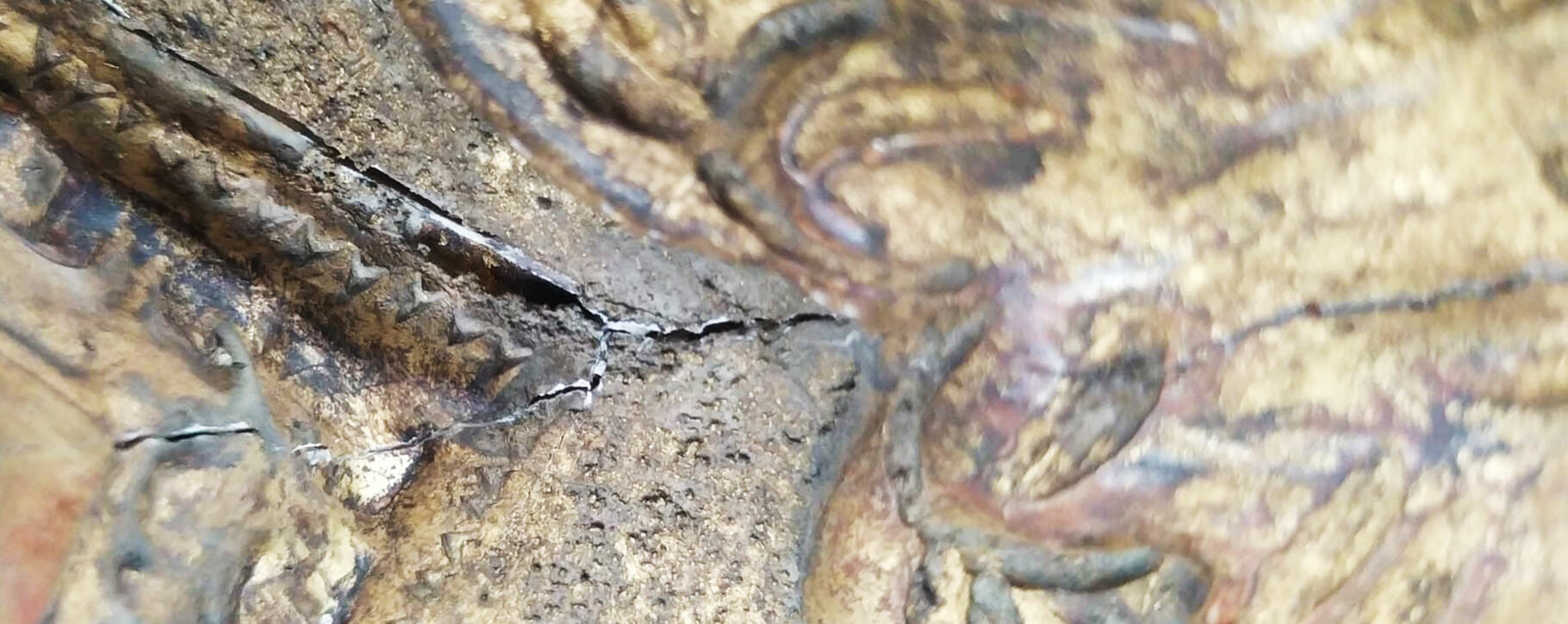 Above: a close up of a crack forming on an antique frame, causing instability to the structure
Above: a close up of a crack forming on an antique frame, causing instability to the structure
A relative humidity of 40-60% is recommended for wooden objects, and as with most objects keeping the humidity stable is the best way to prevent deterioration. Some simple ways to avoid high humidity and fluctuations are by avoiding putting frames on exterior walls, near air conditioning, or near doors/windows that will be open and shut throughout the day.
Gold leaf is photochemically stable so is not affected by light exposure. However, frames should be still kept out of direct sunlight, as the heat generated could affect the other materials. The wood is also susceptible to mould and pest attack. A cool, dry climate below 20°C and 50% RH will help to control these.
Depending on what type of object is displayed in the frame, you should also take the recommended display conditions for those materials into consideration as well.
 Above: a gilded frame before and after restoration by our team, an oil painting and frame can be restored simultaneously and reunited
Above: a gilded frame before and after restoration by our team, an oil painting and frame can be restored simultaneously and reunited
Cleaning gilded frames
When it comes to cleaning gilded frames, less is more. Gilded surfaces are extremely delicate – gold leaf can be as thin as 0.1 micron (1/10,000 of a millimetre) – which means that rigorous cleaning or polishing can abrade the surface.
Using commercial cleaning products such as furniture polish is one of the most common mistakes when cleaning frames. The adhesives used to attach the gold leaf can be dissolved by water and other chemicals in cleaning solutions, which risks the gilding being wiped away.
Regular dry cleaning is the best way to reduce build up of dust and dirt on gilded surfaces. If carried out weekly it can prevent the need for intensive conservation treatment in the future. But only clean your frame if the surface is stable – if the surface is flaking or there are any loose pieces, they could be dislodged by brushing.
 Above: the small swab used by our conservator to gradually remove a build up of dirt and debris from a gilded frame
Above: the small swab used by our conservator to gradually remove a build up of dirt and debris from a gilded frame
The best way to clean frames is to use a soft brush and lightly dust the surfaces once a week. Large watercolour brushes with natural bristles and makeup powder brushes work well for this purpose. To be extra safe, tape over the metal ferrule so that it won’t scratch the gilding if it accidentally knocks against it. You can brush the dust straight into a vacuum, held about 15cm away from the frame, so that it doesn’t resettle on the object.
Avoid using cloths to clean the surface as dust contains tiny abrasive particles which can scratch the gilding if wiped over. If you need to clean the glass in a frame, hold a piece of card against the gilded edge to protect it from damage.
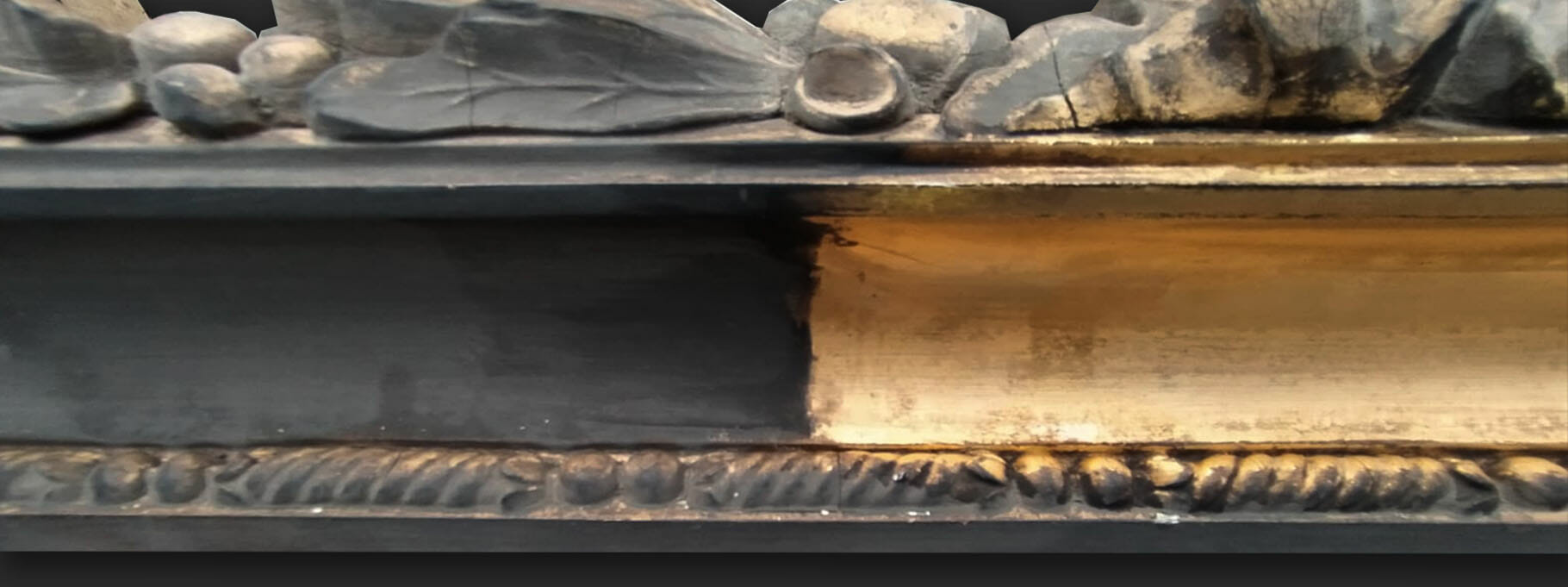 Above: a frame embedded with soot and smoke damage, partially cleaned by our conservation team with tailored solvents
Above: a frame embedded with soot and smoke damage, partially cleaned by our conservation team with tailored solvents
Does my frame need professional treatment?
If your frame has thick surface dirt, abrasion, flaking, broken pieces or insect damage our frame conservators can treat these safely, returning your frame to its prime. Trying to fix these at home can lead to unforeseen problems and further damage.
Frames can be monitored by checking the back of them occasionally for signs of pest infestation including small insect holes or frass (fine brown powder coming from the holes), and fluffy growths which indicate mould. Our team can treat insect and mould infestations to stop further damage and provide advice on how to prevent them in the future.
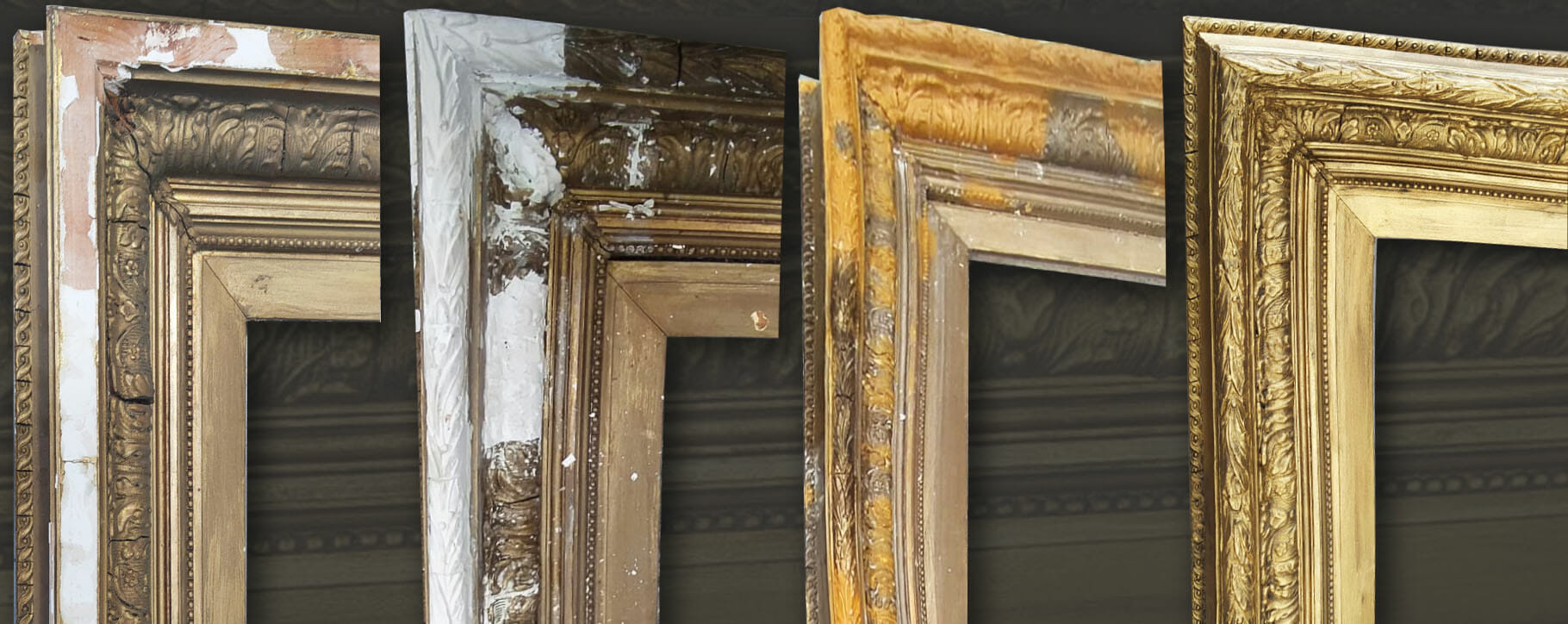 Above: the restoration process of a frame with missing decoration – this is remoulded from surviving areas and then carefully colour-matched and re-gilded
Above: the restoration process of a frame with missing decoration – this is remoulded from surviving areas and then carefully colour-matched and re-gilded
Thick surface dirt is difficult to remove, and our conservators can test and tailor solutions to find the safest and most appropriate for each individual frame. They can also consolidate flaking areas of gilding, reattach loose or broken decoration, and even replicate missing sections. Any abraded areas can be re-gilded to bring back the original lustre of the frame.
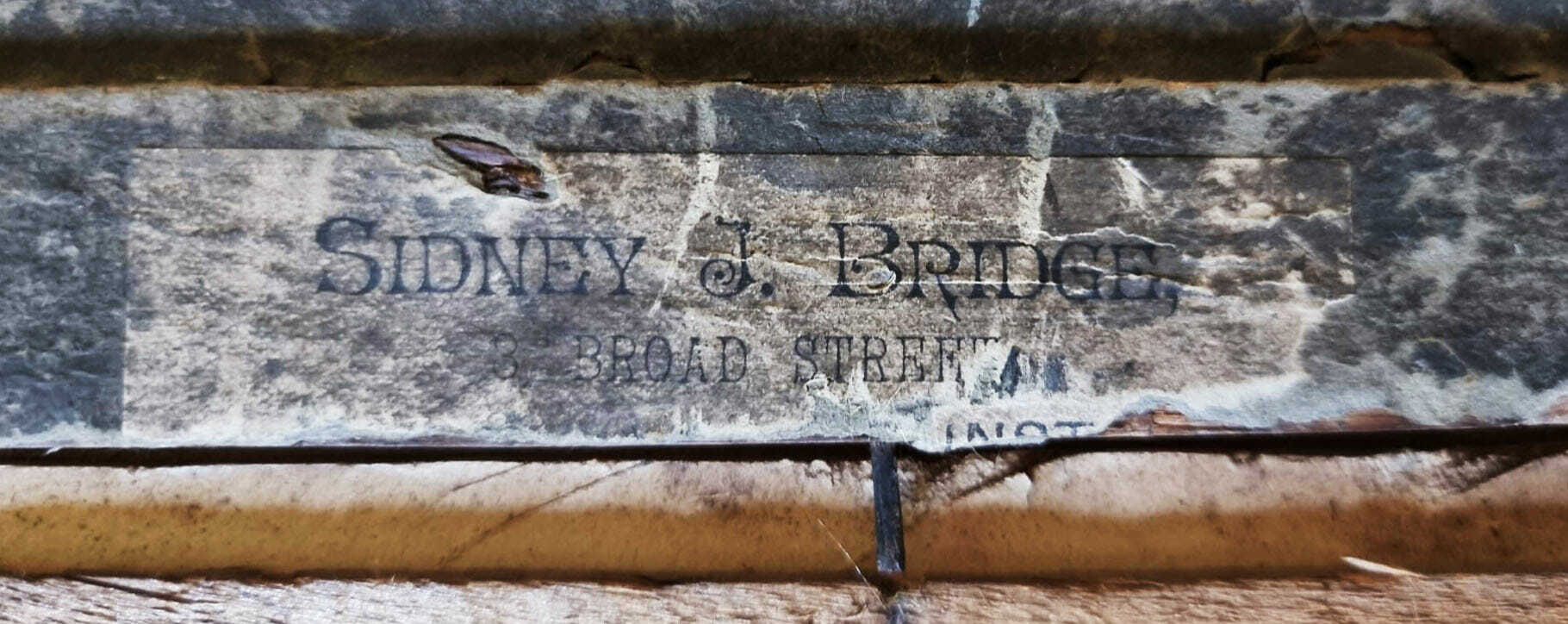 Above: an antique frame label can give indication of age, these labels should be cared for and preserved – our team can apply protective layers to such areas
Above: an antique frame label can give indication of age, these labels should be cared for and preserved – our team can apply protective layers to such areas
Contact our team for further information
If you have any concerns about a gilded frame, please contact our team for swift and helpful guidance, you can email [email protected] or call 0207 112 7576.






